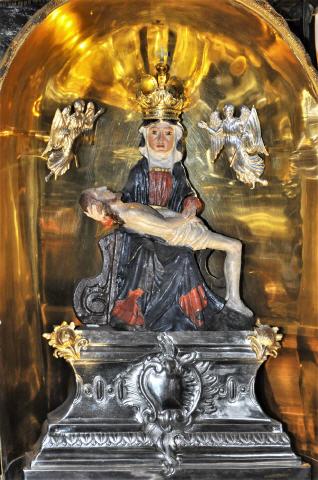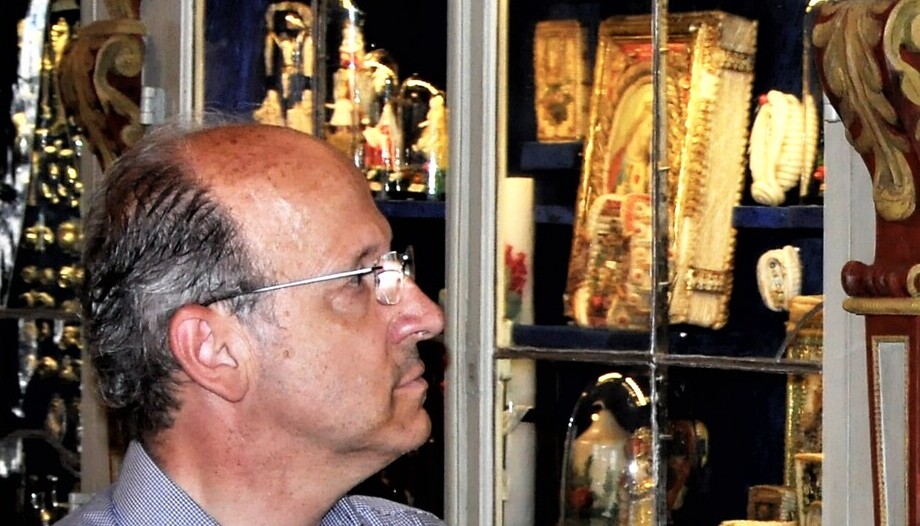









On the north bank of the Danube, not far from the famous wine-growing region of the Danube, the Wachauvisible from afar and with a wide view of the Alps, rises the Marian sanctuary of Maria Taferl as "the jewel on the Taferlberg (Taferl mountain)".. After Mariazell is the second most important shrine in Austria and the largest regional shrine in Lower Austria. Between 250,000 and 300,000 visitors come each year to pray in the minor basilica before the small image of the Pietà of Our Lady of Sorrows.
Devotion to Maria Taferl dates back to the 17th century. In 1633, pastor Thomas Pachmann wanted to cut down an oak tree without noticing the wooden plaque with a cross hanging from it. Miraculously, he was unable to fell the tree, but in trying to do so he injured both legs. When he saw the cross, he asked God for forgiveness and was healed on the spot. Nine years later, Judge Alexander Schinnagl, in a situation of spiritual distress, replaced the cross with an image he had in his home, and as a result obtained relief and healing. When the dry oak began to green again in 1651 and news of apparitions and healings spread, construction of the church was begun in the Baroque style in 1660 and completed more than 60 years later.
In the 17th and 18th centuries, the influx of pilgrims was so great that sometimes twenty-five priests were needed to attend to the pilgrims. It is said that in the centenary of 1760, 700 processions and 19,000 masses were celebrated. The numerous votive offerings and miracle books preserved in the treasury of the pilgrimage church still bear witness to the popularity of the pilgrimage to Maria Taferl.
Under Emperor Joseph II, pilgrimages were banned, and the church, which until then had belonged to Passau in Germany, passed to the Austrian diocese of St. Pölten and became a parish church. After this decline of pilgrimages, also due to the Napoleonic wars, Maria Taferl experienced a revival in the 20th century and especially in the last decades: as in other places in the world, people come from all over the world, sometimes after a long journey, to pray before the altar with the stylized oak, to open their hearts, to receive the sacrament of penance and to participate in Holy Mass.


We spoke with Christian Schüller, who has been instrumental in the management of Maria Taferl for more than three decades as a member of the parish council and the church council, about his experiences. Since 2000, he has been voluntarily responsible for the latest renovation and for the treasury and archives of the sanctuary.
Mr. Schüller, you have lived and worked in Maria Taferl for most of your life. What is so special about this place?
On the one hand, it has become my second home, and on the other, it is a place of grace where countless prayers are poured out. A place that attracts many people with worries and needs, but who also come to give thanks. Even for me, a local, Maria Taferl is an enormous source of strength.
All these years he has worked voluntarily in the parish, as a layman, and he helps in everything that is necessary, he opens the church in the morning and closes it in the afternoon, sometimes he also acts as an altar boy. Have you acquired a special relationship with the Blessed Virgin through this path?
Even as a child I had a deep relationship with the Virgin Mary. I remember the wonderful devotions of the month of May, and above all the Marian "jozos" that I still have in my ears today.
And then, at Maria Taferl, you really can't help but become a devotee of Our Lady of Sorrows. Every day I look at her on the high altar and thank her. But I also ask her for many things. And I am firmly convinced that she has helped me a lot in my life.
For a long time you have been the parish priest's representative on the parish council, that is to say, the second in charge of running the shrine. Can you summarize your activity in some way? What has been the most beautiful thing? What has been the most difficult?
The pilgrimage site has been looked after for the past 50 years by the so-called Hünfelder Oblaten (Hünfeld Oblates). Due to the constant coming and going of the religious, who are here for about seven years on average, I have become something of a guardian and administrator of this place of grace.
Over the years, the tasks have expanded, so that today I am in charge of the financial agenda, the archives, the paraments, the library and the treasury, and really everything that has to do with the church.
The most beautiful thing for me are the moving stories of the people when they bring votive offerings and thus present their gratitude or their petitions to the Virgin.
The most difficult thing is undoubtedly to ensure that we can cover the financial expenses. Since we don't own any land like the surrounding monasteries, for example, we have to finance the employees and all operating expenses with the income from donations. And that is sometimes really very tight.
Up to 300,000 visitors come to Maria Taferl every year. Do they come to pray, or do they come for relaxation? Can you say something about pilgrimages in recent decades?
Sometimes it is noticeable that pilgrimage, or perhaps also hiking, as people call it, is back in fashion. And so, hiking moves people, quite unconsciously, to say a prayer, to collect themselves for prayer and to light a candle. Of course, the geographical location of Maria Taferl also plays a role. You can read many touching stories in books of testimonies, and get an idea of the pilgrimage, hike or bus trip to Maria Taferl.
Are there special events for pilgrims in the church, or in the parish? Is it possible to say that many young people also come?
Of course, there must be special events in the sanctuary. It is a much sought after church for weddings (about 40 or 50 a year), and baptisms (about 60 a year). There are also confirmations and concerts. The parish life itself (we have about 800 faithful), it must be said frankly, takes a back seat to the intense activity of the pilgrimages.
Young people also like to come to Maria Taferl because, for example, they appreciate the range of the five Sunday Masses. In the time before COVID19, we also had Masses for families, which used to be attended by up to 400 people.


Do you remember any special event or encounter related to pilgrimages?
Many of the pilgrimage groups have been coming to Maria Taferl for generations (mostly so-called votive pilgrimages). Over the years, many participants in the pilgrimage groups have become friends of the shrine, and one is happy when one reads in the weekly program that a group from here or there is coming to this holy place this week.
And the young people also come, and so this tradition is also passed on to the next generation. Many take a souvenir, holy water or a gingerbread for those who have stayed at home, to let them know: I was at Taferl.
Since the fire of 1870, the parish of Maria Taferl has also been on pilgrimage to the neighboring parish of Neukirchen.
There are about 20 confessionals in the church. Are all of them still necessary? How is the sacrament of forgiveness experienced here? Do the faithful express their satisfaction at being able to go to confession here?
Maria Taferl has been nicknamed "the confessional of the diocese" for decades. Until a few years ago, two or three priests always had to be in the confessionals on Sundays. People know that at Maria Taferl they can always go to confession. Nowadays, if someone needs to go to confession, they can press a bell that alerts the priest on duty at their smartphone.
Many young couples also like to go to confession here, especially before they get married, and often because they are afraid to confess to their own parish priest. Maria Taferl without confession would be unimaginable.
You are responsible for the treasury, can you describe it in more detail? Approximately how many votive offerings are there? Do you remember any special reactions from visitors? What is your favorite piece in the treasury?
Especially in places of pilgrimage, people like to bring votive offerings. As a form of thanksgiving or to accompany a petition. Even today, although not as much as in the past, some are still brought. The treasure of our basilica is a safe. But it is rather a treasure of faith, because behind each piece there is a story and a petition. That is why each piece is attributed the same value, whether it is a valuable diamond ring from a widow of good standing or a teddy bear brought by a child because his mother has recovered from a serious illness.
These are truly moving stories. Adding up all the votive pictures, there must be a few thousand objects. Many of the visitors also come to show their grandchildren or great-grandchildren the votive offerings of previous generations. Personally, I really like the antique paraments, most of which were made and embroidered by members of the imperial household themselves.
Pope Emeritus Benedict XVI called Maria Taferl "God's lighthouse" in a message of greeting. The lighthouse fits very well with the geographical location on the Danube. Can we say that this also applies to the spiritual dimension, that Maria Taferl also contributes to the spiritual renewal of the country?
I believe that Maria Taferl certainly contributes a lot to the spiritual renewal of the country. Everyone and, dare I say it almost with certainty, who is in Maria Taferl also enters the church. Even if sometimes you get the feeling that people behave as if they were in a museum, moreover, as I mentioned at the beginning, perhaps unconsciously they also say a short prayer, make the sign of the cross or light a candle.
And then it is worthwhile again to make a gesture to Our Lady when closing the church at night, and to thank her for all this. "Mary with the beloved Child, give us all your blessing," with the ejaculation so widespread in the German language, "Maria mit dem Kindlein lieb, uns allen deinen Segen gib."
Austria












